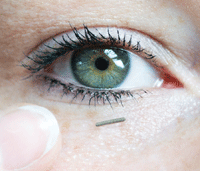With the development of new biosensor technology, diabetic patients may no longer have to put their blood, sweat and tears into glucose monitoring.

The patient’s finger points to the nano-sized biosensor, which combines glucose measurement and digital analysis, and can transmit data to a mobile device. Photo: Fraunhofer Institute for Microelectronic Circuits and Systems IMS
Instead, researchers in Germany have developed a nano-sized biosensor to continuously and noninvasively measure glucose levels using tissue fluids in just sweat or tears.
The 0.5mm by 2mm chip includes a nanopotentiostat as well as the diagnostic system. To measure glucose levels, an enzyme—glucose oxidase—is used to convert glucose into hydrogen peroxide and other chemicals, whose concentration can then be determined with the potentiostat. This measurement is used to calculate the glucose level.
The chip converts the electrochemical signals into digital data that can be transmitted wirelessly to a mobile device. The researchers, a team at the Fraunhofer Institute for Microelectronic Circuits and Systems, say that the sensor uses substantially less power than previous attempts—which increases the durability of the system and would allow the patient to wear the sensor for weeks or even months. Another benefit is that the sensor can be supplied with power through radio frequency.
The hope is that one day this system could be used to control an implanted miniature pump to inject the proper amount of insulin according to the measured glucose levels.

